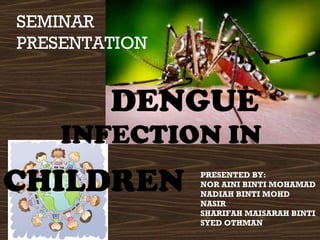
9.dengue seminar
- 1. DENGUE PRESENTED BY: NOR AINI BINTI MOHAMAD NADIAH BINTI MOHD NASIR SHARIFAH MAISARAH BINTI SYED OTHMAN SEMINAR PRESENTATION INFECTION IN CHILDREN
- 14. Dengue Virus Infection asymptomatic symptomatic Undifferentiated fever Dengue fever syndrome Dengue haemorrhagic fever Without haemorrhage With unusual haemorrhage No shock Dengue shock Syndrome Dengue fever (DF) Dengue Haemorrhagic Fever (DHF)
- 18. Grade 1 Fever with constitutional symptoms. A positive Hess test. Grade 2 Spontaneous bleeding (skin ± other bleeds) in addition to manifestations of grade 1 Grade 3 Circulatory failure (rapid weak pulse, pulse pressure < 20mmHg) but systolic BP still normal Grade 4 Profound shock (hypotension, undetectable blood pressure and heart rate) WHO Grading Of DHF/DSS
- 26. ONSET OF DEFERVESCENCE USUALLY OCCURS BETWEEN DAY 3 AND DAY 5 OF ILLNESS
- 29. Increase in vascular permeability Leads to leakage of plasma to extravascular compartment Haemoconcentration (> 20%) and hypovolaemic shock Hypovolemia lead to reflex tachycardia and generalized vasoconstriction due to increase sympathetic output
- 31. The pathogenetic mechanism responsible for the increased vascular permeability in DHF/DSS is not known Abnormal immune response involving the production of cytokines or chemokines, activation of T-lymphocytes and disturbances of haemostatic system are the major changes seen in DHF. Secondary infection with a heterotypic dengue virus is associated with increased risk of developing DHF. It is believed to be due to the antibodydependent enhancement phenomenon.
- 33. infected with dengue develop an immune response to that dengue subtype produced specific antibodies to that subtype specific surface proteins that prevents the virus from binding to macrophage cells and gaining entry another subtype of dengue virus infects the individual virus will activate the immune system to attack it as if it was the first subtype The antibodies bind to the surface proteins but do not inactivate the virus. The immune response attracts numerous macrophages, which the virus proceeds to infect because it has not been inactivated viral infection much more acute The body releases cytokines that cause the endothelial tissue to become permeable which results in DHF and fluid loss from the blood vessels.
- 34. PRINCIPLES OF MANAGEMENT
